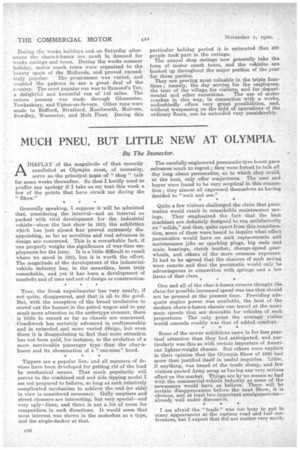MUCH PNEU, BUT LITTLE NEW AT OLYMPIA.
Page 14

If you've noticed an error in this article please click here to report it so we can fix it.
13v The Insvector.
ADISPLAY of the magnitude of that recently concIuded at Olympia, must, of necessity, serve asethe principal topic of " Shop " talk for some weeks thereafter. So that I hardly need to profferany apology if I take as my text this week a few of the points that have struck me during the "Show."
Generally speaking, I suppose it will be admitted that, considering the interval—and an interval so packed with vital development for the industrial vehiele—since the last show in 1913, the exhibition which has just tcl,osed has prorved extremely disappointing, BO far as novelties and real advances in design are concerned. This is a. remarkable fact, if 'one properly weighs the significance of war-time employment for the lorry. It is a little difficult to recall where we stood in 1913, but it is worth the effort. The magnitude of the development of the industrialvehicle industry has, in the meantime, been truly remarkable, and yet it has been a development of numbers and of uses and not of design or construction.
True, the freak experimenter has very nearly, if not quite, disappeared, and that is all to the good. But, with the exception of the broad tendencies to crowd out the bonnet in the petrol. wagon and to pay mnch more attention to. the undertype steamer, there is little to record so far as chassis are concerned. Coachwork has certainly advanced in craftsmanship and in extended and more varied design, but even there it is disappointing to find that more attention has not been paid, for instance, to the evolution of a, more serviceable passenger type than the char-kbanes and its abomination of a "one-man" hood.
Tippers are a popular line, and all manners of devices have been developed for getting rid of the load by mechanical means. That much popularity will accrue to the combined end and side tipping model I am not prepared to believe, so long as such relatively complicated mechanism to achieve the end (or side) in view is considered necessary. Gully emptiers and street cleaners are interesting, but very special—and very ugly—lines, and there is not a lot of room for competition in such directions. It would seem that most interest was shown in the motorbus as a type, and the single-decker at that. The carefully-engineered pneumatic-tyre boost gave salesmen much to regret ; they were forced to talk all day long about pneumatics, as to which they could, at the best, only offer conjectures. The user and buyer were found to be very sceptical in this connection; they almost all expressed themselves as having decided to "wait and see."
Quite a few visitors challenged the claim that pneumatics would result in remarkable maintenance savings. They emphasized the fact that the best machine's are definitely designed to run satisfactorily on "solids," and that, quite apart from this consideration, some of them were heard to inquire what effect pneumatics would have on such replacements and maintenance jobs as sparking plugs, big ends and main bearings, clutch leather, change-speed gearwheels, and others of the more common expenses. It had -to be agreed that the chances of such saving were remote and that the pneumatic would only be advantageous in connection with springs and a few items of that class.
One and all of the char-à-bancs owners thought the claim for possible increased speed was one that should not be pressed at the present time. Providing adequate engine power was available, the best of the modern chars-&-bancs chassis can travel at the maximum speeds that are desirable for vehicles of such 'proportions. The only point the' average visitor would concede readily was that of added comfort.
Some of the newer exhibitors came in for less practical attention than they had anticipated, and particularly was this so with certain importers of American lighter-weight chassis. But others were explicit in their opinion that the Olympia Show of 1920 had more than justified itself in useful inquiries. Little, if anything, was heard of the trade slump, and few visitors quoted Army scrap as having any very serious effect on the market. Things are by no means so bad with the commercial-vehicle industry as some of the newcomers would have us believe. There will be certain disappearances before the next Show, it is obvious, and at least two important amalgamations— already well under discussion.
I am afraid the " trade " was too busy to put in many appearances at the various road and fuel conferences, but I expect that did not matter very much.


























































